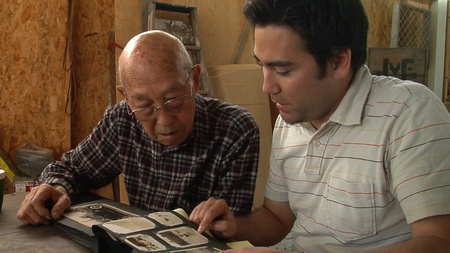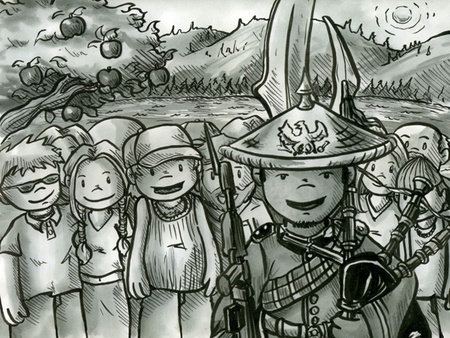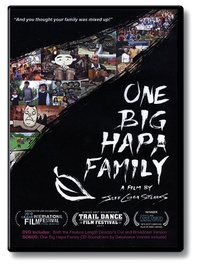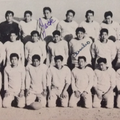Growing up in the predominantly white city of Kelowna, British Columbia, Jeff Chiba Stearns felt very aware of being different from most of the people around him. Born to a Sansei mother and “Euro-mutt” father (of English, Scottish, German, and Russian descent), he was no stranger to the “What are you?” question.
Over the years, Stearns continued to reflect on his cultural identity until eventually he began to illustrate his thoughts (using a process he calls “animation meditation”). The result, in 2005, was “What Are You Anyway?” an animated short about his process of coming to terms with being mixed.
With its upbeat narration and cartoonish style, “What Are You?” feels light but also deeply reflective and honest. The film shows Stearns being teased as a child and young adult to the point that he begins to feel ashamed of his Japanese heritage. Finally, he meets a girl named Jenni who is also half Japanese but feels proud of her ethnicity rather than embarrassed by it. Inspired by Jenni’s confidence, Stearns begins to appreciate his own mixed background as well.
After making “What Are You Anyway?” the filmmaker began work on One Big Hapa Family, a film that blends animation with a more traditional documentary style to explore the experiences of his Japanese Canadian family, whose fourth generation is entirely multi-ethnic.
“This was the first time I ever asked my family what their thoughts were on intermarriage and being a blended and multiethnic family,” he says. “It was surprising to hear people’s experiences… In the documentary I ask the kids, ‘What are you?’ For some of them, this was the first time they ever heard the question.
“That blew me away since I got that question almost every day growing up. I realize that kids these days are not having to answer this question because there is a lot more education on multiculturalism, diversity in schools, and immigration, making this question of curiosity not as popular anymore. That’s what I’m trying to celebrate in One Big Hapa Family. It is the idea that we can be whole and we can be part of many things. Yes, Japanese Canadian is part of what we are and it doesn’t matter if you’re one half, one quarter, or one eighth Japanese Canadian. If you feel attached to any part of you that is Japanese Canadian even if you don’t look Japanese Canadian but feel it internally and are interested in it, you are Japanese Canadian.”
Recently, Discover Nikkei had a chance to speak with Stearns about his films, his identity, and the future of Nikkei communities in North America.
How do you identify ethnically and culturally?
I actually wrote about this in a profile I created for the website Hapa Voice that speaks to how I feel about since making my feature documentary, One Big Hapa Family. Although, I know come a few years from now or even tomorrow I could feel completely different about how I identity ethnically and culturally. Here’s a little excerpt from that profile:
I am 100% Canadian, 100% Nikkei, 100% Japanese Canadian, 100% German Canadian, 100% Russian Canadian, 100% English Canadian, 100% Scottish Canadian. What I am not is half—nor am I a fraction or stuck in-between a hyphen. Personally, I don’t like fractions because I’ve learned that when I break myself down into halves or eighths others perceive my multi-ethnic identity as weak or diluted…I consider myself pretty complete.
Did you grow up knowing the word “hapa,” or did you learn it later?
I first learned about the word ‘hapa’ in 2003 from an article about a part Japanese woman making a film called Hapaness…Having never heard that term before, I started to get excited. There were no ‘hapa’ or mixed clubs at the universities I attended and with being asked all my life, “So what are you?”, I longed to connect with others who shared in a common experience. I guess discovering the term ‘hapa’ for me at that time represented this community I was searching for, or at least a better way to describe myself without having to break myself down into fractions… ‘Hapa’ for me was a way of feeling whole.
Do you think that the word “hapa” helps people of mixed race feel more comfortable with their ethnic identity, or more connected to a broader community of people like them? Do you think there are any negative aspects to the word?
I think terms like ‘hapa’ help people connect to a certain demographic and community when they need it. The word definitely helped me at a time when I was searching for a sense of community. Although, I rarely use the word now since I feel I have become more culturally aware of my identity and I have had more time to talk to people about cultural identity and lecture on multiethnic issues. As well, I agree that using a term like ‘hapa’ can be harmful because it is just that, a term and a label. At the end of the day, if using ‘hapa’ helps people feel better about themselves by finding a sense of identity, I don’t see the harm in it as long as they can respect the origins and social implications the word can entail.

Jeff Chiba Stearns interviews his grandfather for "One Big Hapa Family." Courtesy of Jeff Chiba Stearns.
Do you see as much interracial marriage on your dad’s side of the family as you do on your mom’s?
No, not at all. My dad was the first person in his family’s history, at least while in North America, to marry interracially…if by interracial you mean a Caucasian marrying a [non-Caucasian]. In Canada, we really hate the word race since it’s a social construct and seen as a dirty word. As well, we just don’t have the same history of race as in the U.S. So most people refer to it as multiculturalism or diversity and if you think about it that way, my grandmother who is Russian and German married my grandpa who is English and Scottish. Back during WWII, that was a big no-no for an Englishman to marry a German. So it really depends on how you look at the question in terms of race vs. ethnicity.
Have you been to Japan?
I travelled to Japan in 2005 right after I finished “What Are You Anyways?” I wanted to [go there] to discover my roots. Unfortunately, no one in Japan could tell or believed I was part Japanese. It was the whitest I had ever felt in my entire life. Not being able to speak the language also made me feel a huge disconnect. So I accepted that I was just Canadian. It wasn’t until the second to last day when I was in Japan when I experienced that Zen moment I was searching for. I stopped in a park in the middle of Tokyo and there was a bamboo forest. I was all alone and all I could hear was the sound of wind rustling through the bamboo. I felt at complete ease for the first time in Japan and I just sat there for over an hour. I had a true connection to the land at that moment and could feel the spirit of my ancestors. Sounds cheesy, but I realized that it wasn’t just the people of Japan that I should try to feel connected to, it was the land.
Did the hapa people you spoke with seem to feel connected to the Japanese Canadian community? What do you think will happen to these communities as the multiracial Japanese Canadian population increases? Will they grow or fade away?
I get asked this a lot by the many Japanese Canadian and American groups I speak with and show my films to. The elders are definitely worried that Japanese Canadian and American culture could fade away. Especially seeing how in Canada there is a 95% intermarriage rate, which means that almost all the kids being born today in the community are mixed.
It’s very important for the elders to know that we can mix and we can blend but we’re not going to lose our history and heritage…it will always be there and those kids who are part Japanese are proud of that little part of them that is Japanese Canadian, and that will never change. Many of the quarter-Japanese kids I talked to expressed more interested in Japanese culture and heritage than the Sansei generation who are full Japanese Canadian. In this day and age, it’s cool to be different and stand out and for these kids, that little piece of them that makes them Japanese Canadian is celebrated. Thus, the Japanese Canadian community is not fading or shrinking, it’s growing because with intermarriage we’re gaining so many more people who can be part of our community, making it more diverse, dynamic, and beautiful!
* * * * *
You can find One Big Hapa Family for sale at the Japanese American National Museum Store. For more information or to order a DVD, click here.
* * * * *
© 2012 Japanese American National Museum








